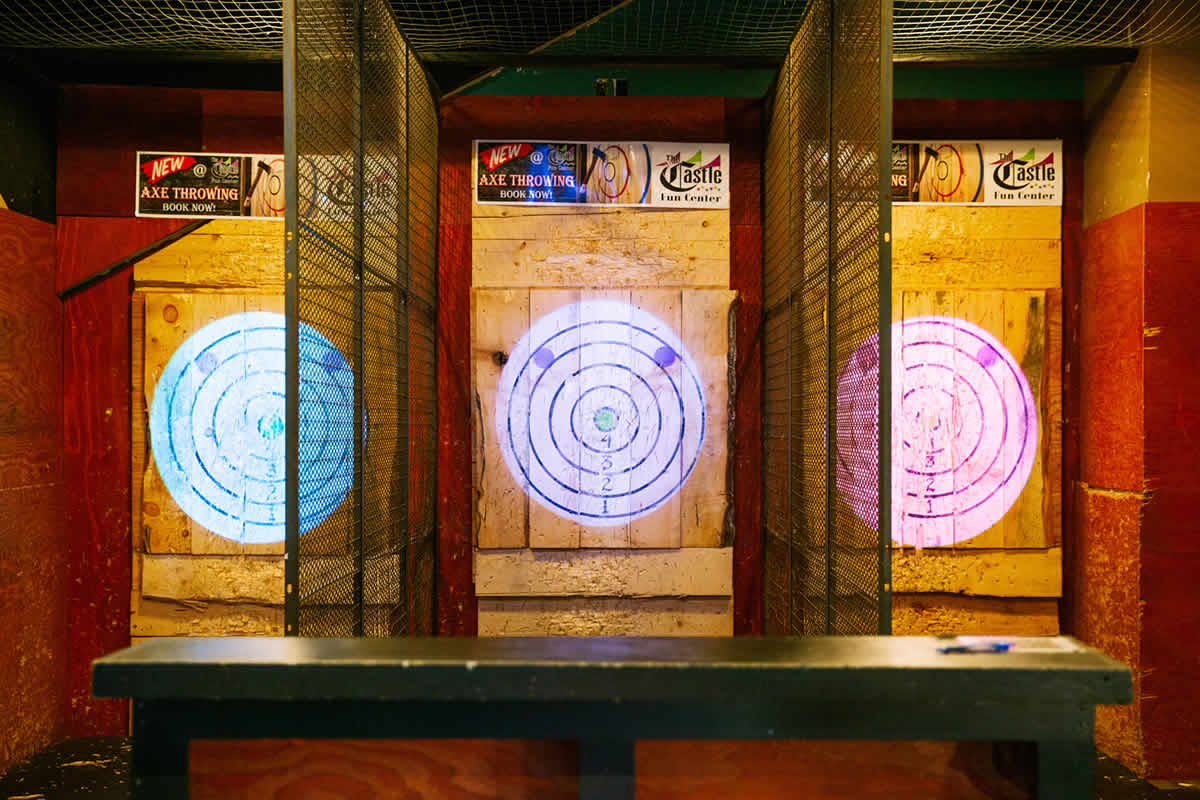Study the Axe Throwing Denver Scene: What You Need to Know
Study the Axe Throwing Denver Scene: What You Need to Know
Blog Article
The Fun of Axe Throwing: Just How This Sport Combines Ability and Adrenaline for a Great Time
Axe throwing has actually arised as a captivating sport that masterfully links the requirement for accurate skill with the thrill of adrenaline, offering participants a unique and appealing experience. The act of hurling an axe in the direction of a target demands concentration and method, all at once fostering an environment of friendship and friendly competition.
The Origins of Axe Throwing
Axe tossing, a recreational activity that has actually gotten considerable popularity recently, traces its origins back to ancient times. This primal sporting activity days back to early human background, when axes were mostly used as devices and weapons. The earliest documents of axe use in affordable contexts are discovered among the Celts and Vikings, who tossed axes for sporting activity in addition to in combat training. The method was not simply a leisure activity yet an essential ability for survival and warfare.
Medieval European warriors, especially throughout the Middle Ages, practiced axe throwing as component of their martial training. The Francisca, a type of throwing axe used by the Franks, became famous for its deadly accuracy. This standard tool was made to be tossed at opponent guards and armor, showcasing its dual energy in both sporting activity and fight.
In even more current background, axe tossing saw a revival in the logging camps of North America in the 20th and 19th centuries. Lumberjacks would participate in pleasant competition, checking their accuracy and stamina by targeting at wood targets. This evolution from a survival skill to a recreational task has led the way for its modern rebirth, with specialized venues and leagues currently commemorating the sport around the world.
Devices You Need
Comprehending the rich history of axe throwing enhances the gratitude of the sport's modern-day model. For entertainment and affordable axe tossing, the most commonly used type is the hatchet, generally considering between 1.25 to 2 pounds with a deal with length of around 16 inches.
Just as crucial is the target. Regulation targets are created from timber, with softwood selections like yearn or cottonwood being chosen for their capacity to soak up and hold the axe. The target is generally split into five concentric circles, each with a particular factor worth, to assist in scoring.
Security equipment, however typically ignored, is important. Protective handwear covers can boost hold and prevent sores, while closed-toed shoes are a must to safeguard feet from gone down axes (axe throwing denver). A well-lit, spacious tossing area, full with security barriers, makes certain a regulated setting where individuals can focus on sharpening their skills.
Standard Techniques Described
Mastering the essential techniques of axe throwing is crucial for both safety and security and efficiency. The leading hand needs to be placed directly listed below the axe head, while the non-dominant hand supports the end of the manage.
Following, focus on the position. Stand with your feet shoulder-width apart, guaranteeing your body is stabilized. Your dominant foot ought to be slightly view it now forward, aligning with your target. This positioning help in maintaining stability and directing power precisely towards the target.

Safety And Security First
Making sure security in axe throwing is paramount to developing a satisfying and injury-free experience. Security gauges start with the location layout. A properly designed axe throwing facility features clear demarcations in between throwing lanes, strong backgrounds to capture roaming axes, and non-slip flooring to avoid accidents. Furthermore, sufficient illumination is important to help individuals keep aesthetic precision and spatial recognition.
Benefits of Axe Throwing
Axe throwing deals a myriad of benefits that expand past easy leisure. Physically, it provides a full-body workout, involving muscles in the arms, shoulders, back, and core. The repetitive motion of throwing the axe also improves hand-eye sychronisation and fine electric motor abilities. For those seeking to improve their total fitness, axe throwing can work as a appealing and dynamic form of workout.
Mentally, axe tossing requires method, emphasis, and accuracy, making it a superb means to sharpen cognitive skills. The concentration required to hit the target can act as a form of mindfulness, permitting participants to clear their minds and minimize anxiety. This psychological interaction can be specifically valuable in aiding people create far better analytical abilities and psychological strength.
Socially, axe throwing is typically enjoyed in team settings, cultivating team-building and sociability. Whether as part of a corporate event or a laid-back getaway with pals, the sport urges interaction and partnership. Furthermore, the public experience of finding out and enhancing with each other can strengthen connections and create lasting memories.
Final Thought

The earliest records of axe use in affordable contexts are discovered amongst the Celts and Vikings, that tossed axes for sport as well as in combat training. Release the axe when your hands are approximately at eye level, allowing the axe's natural turning to direct it in the direction of the target.
A properly designed axe tossing facility attributes clear demarcations between throwing lanes, durable backdrops to catch roaming axes, and non-slip flooring to protect against accidents. Participants should be instructed on the right way to manage and toss the axe, highlighting regulated, calculated movements over forceful tosses.
In summary, axe throwing stands out as a sporting activity that masterfully incorporates precision, skill, and adrenaline.
Report this page